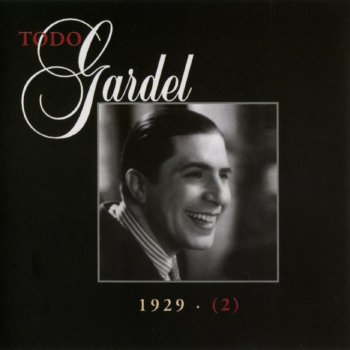El Barbijo - Carlos Gardelперевод на английский
Un
gaucho
bravo,
flor
de
la
raza
A
brave
gaucho,
flower
of
the
race
Llegó
a
la
tropa
con
su
gatea'o
Arrived
to
the
troop
with
his
spotted
horse
Jirón
sangriento
de
su
coraje
A
bloody
shred
of
his
courage
Con
un
barbijo
se
ve
marca'o
With
a
mustache,
he
is
marked
Un
viejo
zorro
pregunta
al
gaucho
An
old
fox
asks
the
gaucho
"¿Cuál
es
la
historia
del
costurón?"
"What's
the
story
of
the
scar?"
Y
el
mozo,
altivo,
mirar
de
tigre
And
the
young
man,
haughty,
with
a
tiger's
gaze
La
historia
cuenta,
junto
al
fogón
Tells
the
story,
by
the
fire
La
china
linda
que
está
en
mi
rancho
The
beautiful
woman
who
is
at
my
ranch
Un
tal
carancho
me
la
envidió
A
certain
buzzard
envied
her
Robarme
quiso
la
prienda
amada
He
wanted
to
steal
my
beloved
darling
Y
en
la
trenzada
me
las
pagó
And
in
the
brawl,
he
paid
the
price
Los
ojos
pumas
brillaron,
fieros
My
puma
eyes
flashed,
fierce
Y
en
los
aceros
relampagueó
And
the
steel
flashed
like
lightning
Marcó
mi
cara
con
un
barbijo
He
marked
my
face
with
a
mustache
Pero,
ni
ay
dijo
cuando
cayó
But,
he
didn't
even
whimper
when
he
fell
El
gaucho
bravo,
mirar
de
tigre
The
brave
gaucho,
with
a
tiger's
gaze
Montó
en
su
pingo
color
gatea'o
Mounted
his
spotted
horse
Y,
al
despedirse,
les
dijo
a
todos:
And,
as
he
said
goodbye,
he
told
everyone:
"No
es
por
ser
maula
que
me
han
marca'o"
"It's
not
because
I'm
a
coward
that
I'm
marked"
Si
alguno
duda
de
mis
palabras
If
anyone
doubts
my
words
Que
salga
y
hable
con
el
facón
Let
him
come
out
and
speak
with
the
knife
Es
ley
de
criollos
jugar
la
vida
It's
the
law
of
gauchos
to
gamble
their
lives
Cuando
les
tocan
el
corazón
When
someone
touches
their
hearts
La
china
linda
que
está
en
mi
rancho
The
beautiful
woman
who
is
at
my
ranch
Un
tal
carancho
me
la
envidió
A
certain
buzzard
envied
her
Robarme
quiso
la
prienda
amada
He
wanted
to
steal
my
beloved
darling
Y
en
la
trenzada
me
las
pagó
And
in
the
brawl,
he
paid
the
price
Los
ojos
pumas
brillaron,
fieros
My
puma
eyes
flashed,
fierce
Y
en
los
aceros
relampagueó
And
the
steel
flashed
like
lightning
Marcó
mi
cara
con
un
barbijo
He
marked
my
face
with
a
mustache
Pero,
ni
ay
dijo
cuando
cayó
But,
he
didn't
even
whimper
when
he
fell
Оцените перевод

1
Yo Nací para Tí, Tú Serás para Mí
2 Parlez-Moi D'amour
3 Medallita de la Suerte
4 Matala
5 Mis Flores Negras
6 Haragán
7 La Casita Está Triste
8 Sus Ojos Se Cerraron
9 Apure Delantero Buey
10 Buey Manno
11 Bésame en la Boca
12 Barra Querida
13 El Barbijo
14 Aquella Cantina de la Ribera
15 Carnaval
16 Senda florida
17 Recuerdo Malevo
18 Leguisamo Solo
19 El Bulin de la Calle Ayacucho
20 Rosa De Otoño
21 Callecita de Mi Barrio
22 Queja Indiana
23 Galleguita
24 La Hija De Japonesita
25 Prisionero
26 Anclao en Paris
27 Ausencia
28 Chorra
29 Malevaje
30 Viejo smoking
31 Milonga Sentimental
32 Ventanita de Arrabal
33 Caminito Soleado
34 Cara Rota
35 La Cumparsita
36 Siga El Corso
37 Almagro
38 Noche de Reyes
39 La muchacha del circo
40 La Reina Del Tango
41 Del Barrio De Las Latas
42 Mi Noche Triste
43 La Borrachera Del Tango
44 Tomo y Obligo
45 Cuando Tú No Estás
46 Fea
47 Bajo Belgrano
48 Compadron
49 Esclavas blancas
50 Te Aconsejo Que Me Olvides
51 Come Se Canta en Napoles
52 La Catedradica
53 Pelao
54 Machete
55 El Rosal
56 Dos en Uno
57 Viejo Curda
58 Mi Suegra No Me Quiere
59 Nubes De Humo
60 Pobre Chica
61 Intimas
62 Muchachos, Silencio
63 En Un Pueblito De España
64 Pompas
65 De Puro Guapo
66 Una Tarde
67 Copen La Banca
68 Adiós, Que Te Vaya Bien
69 Trianera
70 Farabute
71 Pan Comido
72 Organito de la Trade
73 Sanjuanina de Mi Amor
2 Parlez-Moi D'amour
3 Medallita de la Suerte
4 Matala
5 Mis Flores Negras
6 Haragán
7 La Casita Está Triste
8 Sus Ojos Se Cerraron
9 Apure Delantero Buey
10 Buey Manno
11 Bésame en la Boca
12 Barra Querida
13 El Barbijo
14 Aquella Cantina de la Ribera
15 Carnaval
16 Senda florida
17 Recuerdo Malevo
18 Leguisamo Solo
19 El Bulin de la Calle Ayacucho
20 Rosa De Otoño
21 Callecita de Mi Barrio
22 Queja Indiana
23 Galleguita
24 La Hija De Japonesita
25 Prisionero
26 Anclao en Paris
27 Ausencia
28 Chorra
29 Malevaje
30 Viejo smoking
31 Milonga Sentimental
32 Ventanita de Arrabal
33 Caminito Soleado
34 Cara Rota
35 La Cumparsita
36 Siga El Corso
37 Almagro
38 Noche de Reyes
39 La muchacha del circo
40 La Reina Del Tango
41 Del Barrio De Las Latas
42 Mi Noche Triste
43 La Borrachera Del Tango
44 Tomo y Obligo
45 Cuando Tú No Estás
46 Fea
47 Bajo Belgrano
48 Compadron
49 Esclavas blancas
50 Te Aconsejo Que Me Olvides
51 Come Se Canta en Napoles
52 La Catedradica
53 Pelao
54 Machete
55 El Rosal
56 Dos en Uno
57 Viejo Curda
58 Mi Suegra No Me Quiere
59 Nubes De Humo
60 Pobre Chica
61 Intimas
62 Muchachos, Silencio
63 En Un Pueblito De España
64 Pompas
65 De Puro Guapo
66 Una Tarde
67 Copen La Banca
68 Adiós, Que Te Vaya Bien
69 Trianera
70 Farabute
71 Pan Comido
72 Organito de la Trade
73 Sanjuanina de Mi Amor
Внимание! Не стесняйтесь оставлять отзывы.